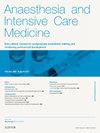Total intravenous anaesthesia in children: a practical guide
IF 0.3
Q4 ANESTHESIOLOGY
引用次数: 0
Abstract
Total intravenous anaesthesia (TIVA) is the delivery of general anaesthesia entirely via the intravenous route. This can be achieved through a variety of drugs. The most common combination used is propofol and a short-acting opiate, such as remifentanil. Different target- controlled infusion (TCI) models are used, depending on the age of the child.
TIVA use in paediatric anaesthesia offers certain benefits over volatile anaesthesia. Advantages for the patient include reduced postoperative nausea and vomiting (PONV), delirium, time in recovery and less airway reactivity. It provides a safe method of anaesthesia for children with certain conditions who cannot have volatile anaesthesia. There are also environmental benefits to using TIVA instead of volatile anaesthesia and surgical benefits, for example in cases requiring somatosensory monitoring.
TIVA use in paediatrics is increasing and this article will provide an overview of use in the paediatric population as well as some of the barriers and disadvantages.
儿童全静脉麻醉:实用指南
全静脉麻醉(TIVA)是指完全通过静脉途径进行全身麻醉。这可以通过多种药物实现。最常用的组合是异丙酚和短效阿片类药物,如瑞芬太尼。与挥发性麻醉相比,TIVA 在儿科麻醉中的使用具有一定的优势。与挥发性麻醉相比,TIVA 在儿科麻醉中的应用具有一定的优势。对患者而言,TIVA 的优势包括减少术后恶心和呕吐 (PONV)、谵妄、恢复时间以及降低气道反应性。它为患有某些疾病、不能进行挥发性麻醉的儿童提供了一种安全的麻醉方法。使用 TIVA 代替挥发性麻醉对环境也有好处,对手术也有好处,例如在需要体感监测的病例中。TIVA 在儿科的使用正在增加,本文将概述其在儿科人群中的使用情况以及一些障碍和缺点。
本文章由计算机程序翻译,如有差异,请以英文原文为准。
求助全文
约1分钟内获得全文
求助全文
来源期刊

Anaesthesia and Intensive Care Medicine
ANESTHESIOLOGY-
CiteScore
0.50
自引率
0.00%
发文量
152
期刊介绍:
Anaesthesia and Intensive Care Medicine, an invaluable source of up-to-date information, with the curriculum of both the Primary and Final FRCA examinations covered over a three-year cycle. Published monthly this ever-updating text book will be an invaluable source for both trainee and experienced anaesthetists. The enthusiastic editorial board, under the guidance of two eminent and experienced series editors, ensures Anaesthesia and Intensive Care Medicine covers all the key topics in a comprehensive and authoritative manner. Articles now include learning objectives and eash issue features MCQs, facilitating self-directed learning and enabling readers at all levels to test their knowledge. Each issue is divided between basic scientific and clinical sections. The basic science articles include anatomy, physiology, pharmacology, physics and clinical measurement, while the clinical sections cover anaesthetic agents and techniques, assessment and perioperative management. Further sections cover audit, trials, statistics, ethical and legal medicine, and the management of acute and chronic pain.
 求助内容:
求助内容: 应助结果提醒方式:
应助结果提醒方式:


